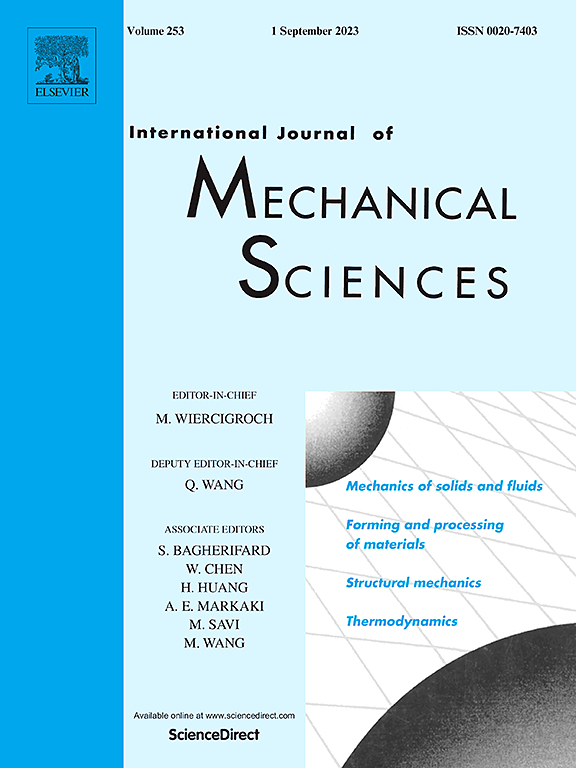A rigid-flexible dynamic model of flexoelectric robotic metamaterials with large in-plane motions
IF 7.1
1区 工程技术
Q1 ENGINEERING, MECHANICAL
International Journal of Mechanical Sciences
Pub Date : 2025-02-01
DOI:10.1016/j.ijmecsci.2025.109943
引用次数: 0
Abstract
We propose, in this paper, a new rigid-flexible coupling dynamic model for robotic metamaterials. A floating coordinate system is employed to decompose the displacement of the beam. Based on the three-dimensional constitutive equations of center-symmetric flexoelectric materials, the constitutive equations of the flexoelectric beam are derived. The strain, strain gradient, and electric field are expressed in the local coordinate system based on the Euler-Bernoulli beam theory. The velocity and acceleration at any point in the system are determined in the global coordinate system. Through the principle of virtual work, the governing equations and the corresponding boundary conditions for the dynamic coupled flexoelectric beam are established. With the established model, an in-depth analysis is carried out to investigate the relationship between the displacement and the electric field under diverse rigid motions. Numerical results indicate that when the beam is subjected to an impact along the axial direction, an electric field along the same direction will be generated within the beam. When it is subjected to a shear force, an electric field in the thickness direction will be generated. We also find that the magnitude of the generated electric potential is proportional to the magnitude of the applied force. Furthermore, we explore the impact of an external electric field on the deflection of a beam when it is swinging. It is shown that a positive (negative) external electric field, which synchronized with the swing, increases (reduced) the deflection of the beam. Hence, by applying an appropriate external electric field, the maximum deflection within the beam can be tuned. This result is of great significance to the field of intelligent materials and structures. The present work could provide a theoretical basis for the realization of obstacle perception, hybrid force/position control, and active control of deformation by using flexoelectric dielectrics in metamaterial robots.

求助全文
约1分钟内获得全文
求助全文
来源期刊

International Journal of Mechanical Sciences
工程技术-工程:机械
CiteScore
12.80
自引率
17.80%
发文量
769
审稿时长
19 days
期刊介绍:
The International Journal of Mechanical Sciences (IJMS) serves as a global platform for the publication and dissemination of original research that contributes to a deeper scientific understanding of the fundamental disciplines within mechanical, civil, and material engineering.
The primary focus of IJMS is to showcase innovative and ground-breaking work that utilizes analytical and computational modeling techniques, such as Finite Element Method (FEM), Boundary Element Method (BEM), and mesh-free methods, among others. These modeling methods are applied to diverse fields including rigid-body mechanics (e.g., dynamics, vibration, stability), structural mechanics, metal forming, advanced materials (e.g., metals, composites, cellular, smart) behavior and applications, impact mechanics, strain localization, and other nonlinear effects (e.g., large deflections, plasticity, fracture).
Additionally, IJMS covers the realms of fluid mechanics (both external and internal flows), tribology, thermodynamics, and materials processing. These subjects collectively form the core of the journal's content.
In summary, IJMS provides a prestigious platform for researchers to present their original contributions, shedding light on analytical and computational modeling methods in various areas of mechanical engineering, as well as exploring the behavior and application of advanced materials, fluid mechanics, thermodynamics, and materials processing.
 求助内容:
求助内容: 应助结果提醒方式:
应助结果提醒方式:


